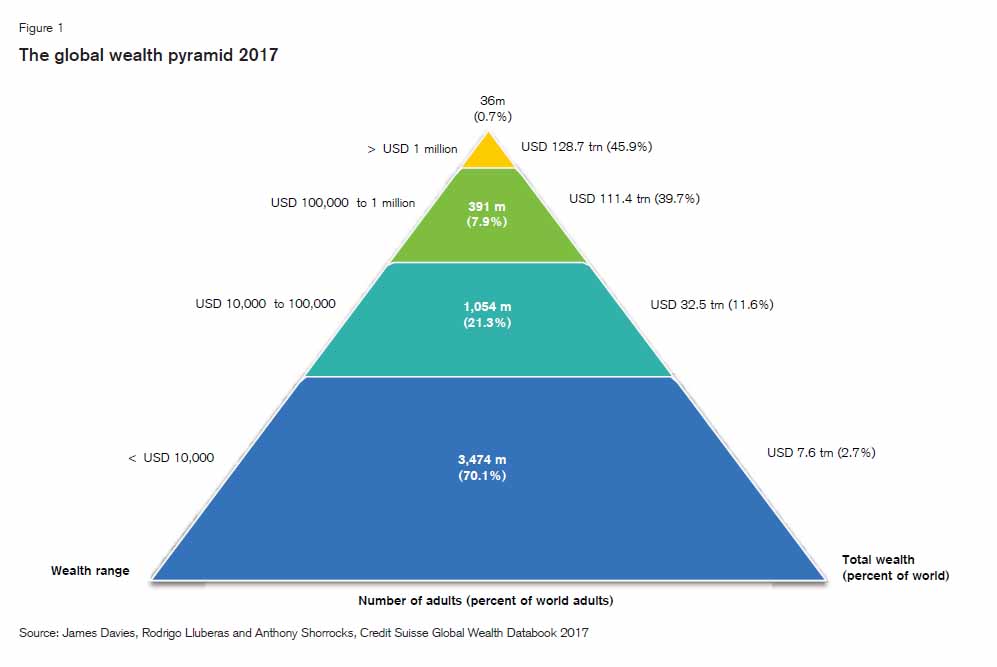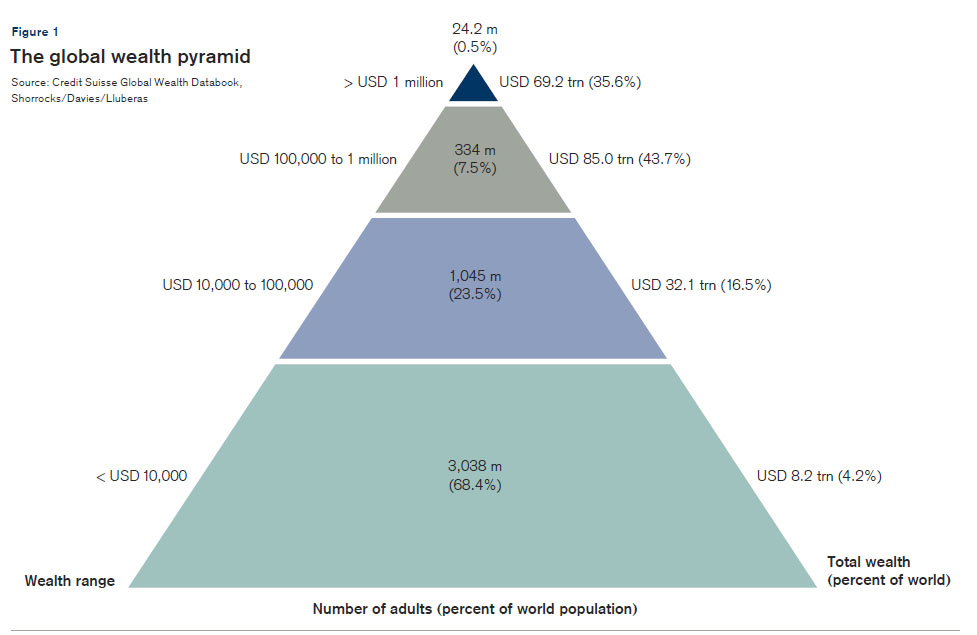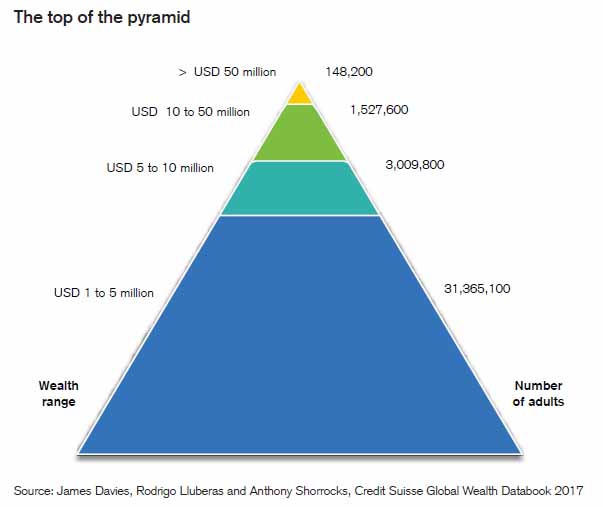The Richest 1% Now Own More than 50% of the World’s Wealth
CAPITALISM, 27 Nov 2017
The World Has More Millionaires than Ever before. They’re Worth $63.5 Trillion.
 14 Nov 2017 – The richest 1% now owns more than half of all the world’s household wealth, according to analysts at Credit Suisse. And they say inequality is only going to get worse over the coming years, with millennials having a particularly tough time.
14 Nov 2017 – The richest 1% now owns more than half of all the world’s household wealth, according to analysts at Credit Suisse. And they say inequality is only going to get worse over the coming years, with millennials having a particularly tough time.
The Swiss bank released its latest Global Wealth Report today, together with a statement that contained the immortal phrase, “The outlook for the millionaire segment is more optimistic than for the bottom of the wealth pyramid.”
The research showed that there are increasing numbers of dollar millionaires. This is partly because the strength of the euro has created 620,000 more of them in Germany, France, Italy and Spain (conversely, depreciating currencies in the U.K. and Japan have seen 34,000 and over 300,000 people in those countries respectively lose the status).
But almost half of the new dollar millionaires are in the U.S. itself. “So far, the Trump Presidency has seen businesses flourish and employment grow, though the ongoing supportive role played by the Federal Reserve has undoubtedly played a part here as well, and wealth inequality remains a prominent issue,” said Michael O’Sullivan, CIO for International Wealth Management at Credit Suisse.
Credit Suisse expects to see a 22% rise in dollar millionaires by 2022, from 36 million to 44 million. The problem is, the numbers of adults who have less than $10,000 are expected to shrink by only 4%.
The bank’s researchers see wealth inequality as largely being a result of the financial crisis— it rose across the world between 2007 and 2016, because financial assets were growing faster than non-financial assets. The top 1% started the millennium owning 45.5% of all wealth, and now they have 50.1%.
As for what’s been happening since mid-2016, Credit Suisse described a mixed picture. Non-financial wealth has been increasing “substantially,” but inequality is still rising.
“Despite higher mean wealth per adult, median wealth fell again this year in Africa, Asia-Pacific and Latin America. Our projections for 2022 suggest more pessimistic scenarios for the immediate years ahead,” the researchers said.
“Looking at the bottom of the wealth distribution, 3.5 billion people—corresponding to 70% of all adults in the world—own less than $10,000. Those with low wealth tend to be disproportionately found among the younger age groups, who have had little chance to accumulate assets, but we find that millennials face particularly challenging circumstances compared to other generations,” they wrote.
Essentially, millennials are more likely to be unemployed or earning less, priced out of the housing market, and unable to get a pension. Baby boomers have most of the wealth and the housing, so “millennials are doing less well than their parents at the same age.”
Millennials may be better educated than earlier generations, but Credit Suisse’s researchers said they expected only a “minority of high achievers and those in high-demand sectors such as technology or finance to effectively overcome the ‘millennial disadvantage.’”
___________________________________________
 David Meyer is a writer based in Berlin.
David Meyer is a writer based in Berlin.
DISCLAIMER: The statements, views and opinions expressed in pieces republished here are solely those of the authors and do not necessarily represent those of TMS. In accordance with title 17 U.S.C. section 107, this material is distributed without profit to those who have expressed a prior interest in receiving the included information for research and educational purposes. TMS has no affiliation whatsoever with the originator of this article nor is TMS endorsed or sponsored by the originator. “GO TO ORIGINAL” links are provided as a convenience to our readers and allow for verification of authenticity. However, as originating pages are often updated by their originating host sites, the versions posted may not match the versions our readers view when clicking the “GO TO ORIGINAL” links. This site contains copyrighted material the use of which has not always been specifically authorized by the copyright owner. We are making such material available in our efforts to advance understanding of environmental, political, human rights, economic, democracy, scientific, and social justice issues, etc. We believe this constitutes a ‘fair use’ of any such copyrighted material as provided for in section 107 of the US Copyright Law. In accordance with Title 17 U.S.C. Section 107, the material on this site is distributed without profit to those who have expressed a prior interest in receiving the included information for research and educational purposes. For more information go to: http://www.law.cornell.edu/uscode/17/107.shtml. If you wish to use copyrighted material from this site for purposes of your own that go beyond ‘fair use’, you must obtain permission from the copyright owner.

